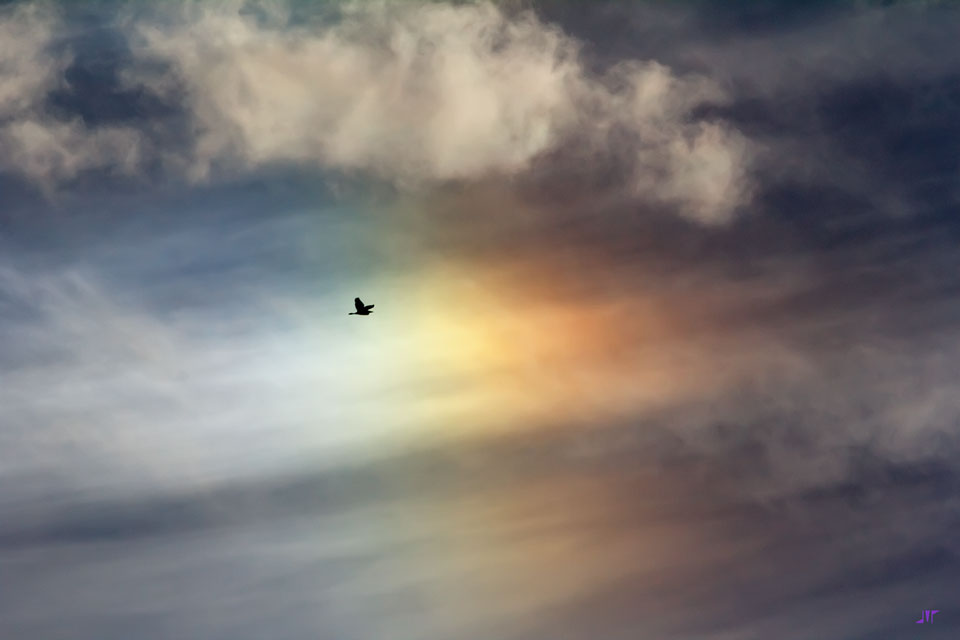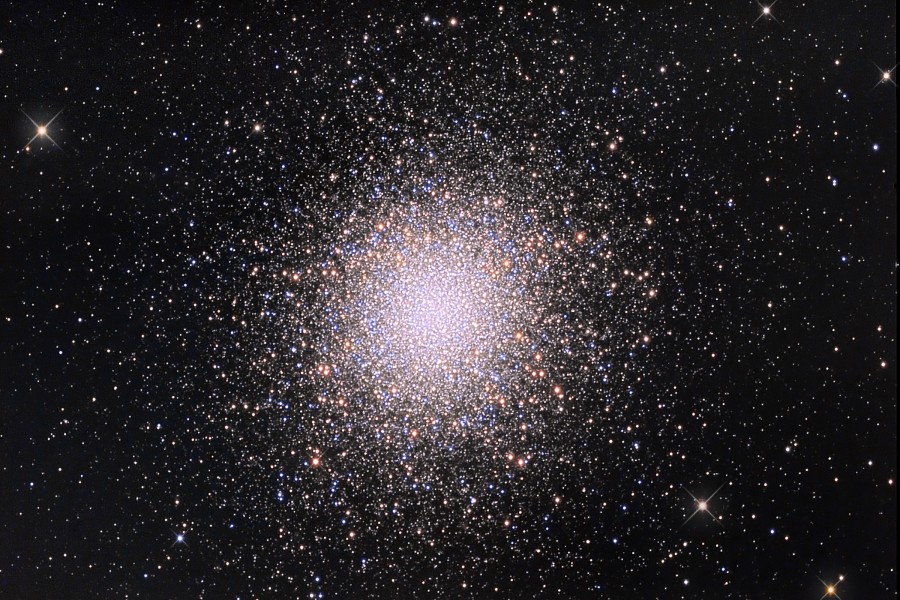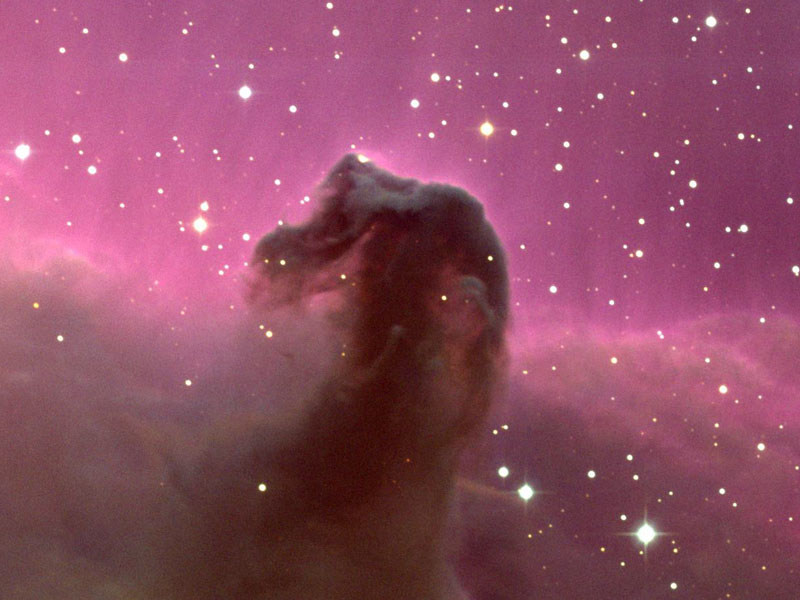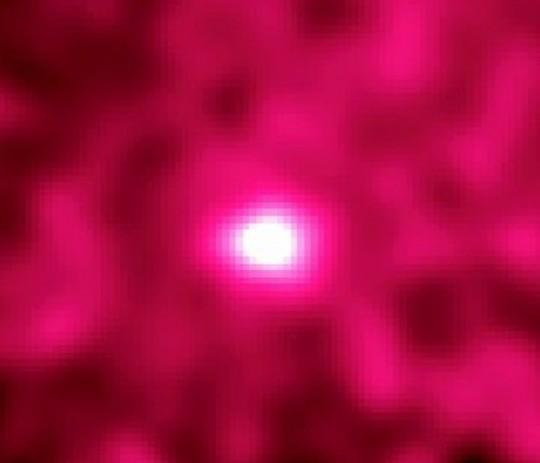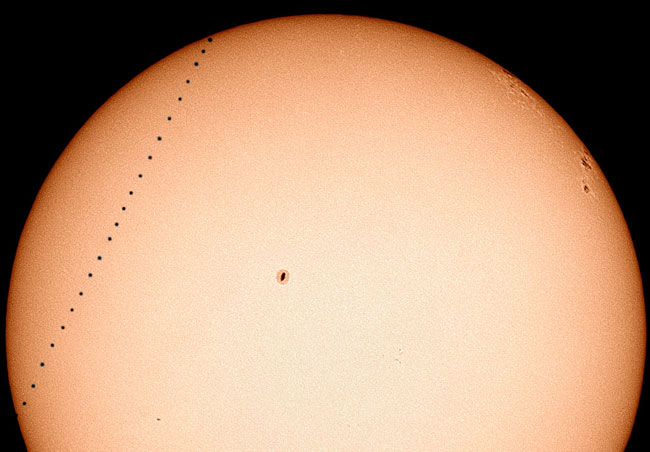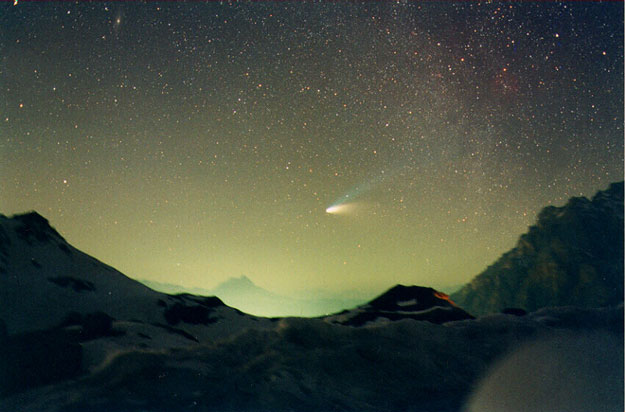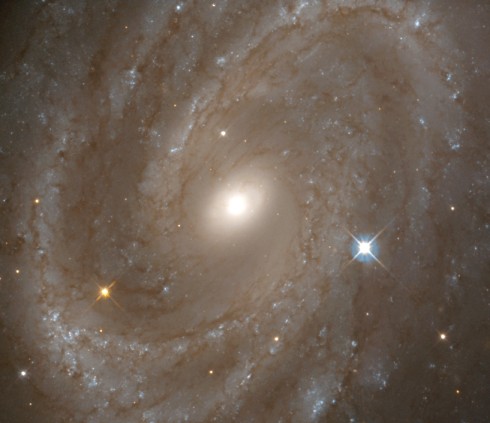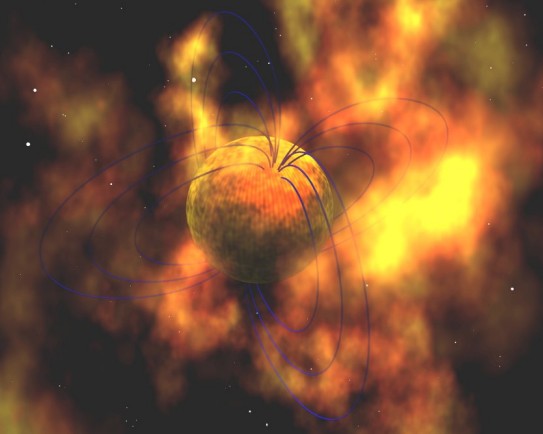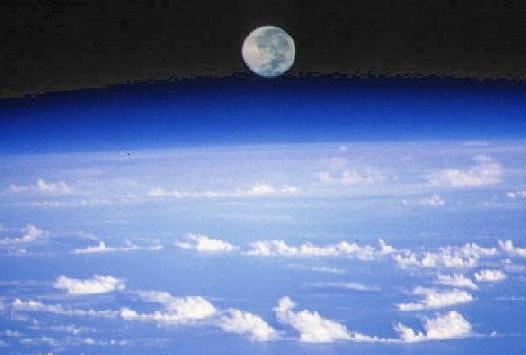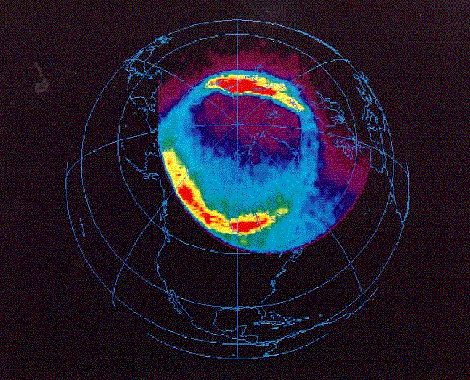| << Previous | Index | Next >> |
2015
Click to play embedded YouTube video.
Video Credit: NASA, Johns Hopkins U. Applied Physics Lab., Southwest Research Inst.
2014
2013 Have you ever seen a little rainbow off to the side of the Sun? Rare but rewarding to see, such spectacles are known as sundogs, mock suns or parhelia. Sundogs are just sunlight refracting through hexagonal falling ice crystals in the Earth's atmosphere. When thin ice crystals flitter down nearly horizontally, they best refract sunlight sideways and create sundogs. Alternatively, randomly oriented ice crystals may create a complete circular sun halo. Sundogs occur 22 degrees to each side of a setting or rising Sun, although sometimes nearby clouds can block one or both. The above image was taken through a polarizing filter during October 2012 in Mérida, Spain.
2012
[imghover6=http://apod.nasa.gov/apod/image/1205/me ... it_960.jpg]http://apod.nasa.gov/apod/image/1205/me ... ed_960.jpg[/imghover6]Image Credit: SOHO - EIT Consortium, NASA
2011
[imghover6=http://apod.nasa.gov/apod/image/1105/Mi ... hi1100.jpg]http://apod.nasa.gov/apod/image/1105/Mi ... hi1100.jpg[/imghover6]Image Credit & Copyright: Babak Tafreshi (TWAN)
2010 In 1716, English astronomer Edmond Halley noted, "This is but a little Patch, but it shews itself to the naked Eye, when the Sky is serene and the Moon absent." Of course, M13 is now modestly recognized as the Great Globular Cluster in Hercules, one of the brightest globular star clusters in the northern sky. Telescopic views reveal the spectacular cluster's hundreds of thousands of stars. At a distance of 25,000 light-years, the cluster stars crowd into a region 150 light-years in diameter, but approaching the cluster core upwards of 100 stars could be contained in a cube just 3 light-years on a side. For comparison, the closest star to the Sun is over 4 light-years away. Along with the cluster's dense core, the outer reaches of M13 are highlighted in this sharp color image. The cluster's evolved red and blue giant stars show up in yellowish and blue tints.
2009 Why are many large craters on Mercury relatively smooth inside? Recent images from the robotic MESSENGER spacecraft that flew by Mercury last October show previously uncharted regions of Mercury that have large craters with an internal smoothness similar to the maria on Earth's own Moon. Therefore, like our Moon's maria, these craters on Mercury are thought to have been flooded by lava floes that are old but not as old as the surrounding more highly cratered surface. The above image mosaic of the western limb of Mercury was created by MESSENGER as it approached the Solar System's innermost planet last October. Old and heavily textured terrain runs across much of the image bottom, while across the middle left lies comparatively smooth impact basins where small craters may appear similar at first to protruding hills. MESSENGER will buzz past Mercury again later this year before entering orbit in 2011.
2008 The Phoenix lander's footpads are about the size of a dinner plate. One of three is shown at the right, covered with Martian soil after a successful soft landing on the Red Planet on May 25. Amazingly, the left panel image is of the spacecraft during its descent phase, captured by the HiRISE camera onboard Mars Reconnaissance Orbiter -- the first image ever of a spacecraft descending to the surface of another planet. Taken from a range of 750 kilometers, the picture shows Phoenix suspended beneath its unfurling, 10 meter-wide parachute, against the much darker Martian surface. The lander is still attached to its protective backshell. Phoenix released its parachute at an altitude of 12.6 kilometers. Using rockets to further reduce its speed for landing, Phoenix now rests in the northern polar region of Mars at about 68 degrees latitude.
2007 One of the most identifiable nebulae in the sky, the Horsehead Nebula in Orion, is part of a large, dark, molecular cloud. Also known as Barnard 33, the unusual shape was first discovered on a photographic plate in the late 1800s. The red glow originates from hydrogen gas predominantly behind the nebula, ionized by the nearby bright star Sigma Orionis. The darkness of the Horsehead is caused mostly by thick dust, although the lower part of the Horsehead's neck casts a shadow to the left. Streams of gas leaving the nebula are funneled by a strong magnetic field. Bright spots in the Horsehead Nebula's base are young stars just in the process of forming. Light takes about 1500 years to reach us from the Horsehead Nebula. The above image was taken with the 0.9-meter telescope at Kitt Peak National Observatory.
2006 If you could see gamma rays - photons with a million or more times the energy of visible light - the Moon would appear brighter than the Sun! The startling notion is demonstrated by this image of the Moon from the Energetic Gamma Ray Experiment Telescope (EGRET) in orbit on NASA's Compton Gamma Ray Observatory from April 1991 to June 2000. Then, the most sensitive instrument of its kind, even EGRET could not see the quiet Sun which is extremely faint at gamma-ray energies. So why is the Moon bright? High energy charged particles, known as cosmic rays, constantly bombard the unprotected lunar surface generating gamma-ray photons. EGRET's gamma-ray vision was not sharp enough to resolve a lunar disk or any surface features, but its sensitivity reveals the induced gamma-ray moonglow. So far unique, the image was generated from eight exposures made during 1991-1994 and covers a roughly 40 degree wide field of view with gamma-ray intensity represented in false color.
2005 Titan's odd spot could be a cloud, but if so, it's a persistent one. Peering into the thick, hazy atmosphere of Saturn's largest moon, cameras on board the Cassini spacecraft found a bright spot at the same location during Titan encounters in 2005 and 2004. Seen near Titan's upper edge in this false-color image from the VIMS instrument, the spot is almost 500 kilometers wide, and is brightest at infrared wavelengths. In addition to suggesting the uniquely colored spot is a persistent cloud possibly controlled by surface features, researchers also entertain the idea that the spot is caused by unusual surface material or extremely tall mountains. They also note the bright infrared spot could be hot. Further clues to the odd spot's nature will come during a planned encounter in July 2006 when Cassini's cameras will look at the spot during Titan's night. If it glows at night, it's hot.
2004 Wielding a very wide-angle lens, astronomer Gordon Garradd was able to capture two naked-eye comets in one picture looking toward the west from Loomberah, New South Wales, Australia. At the far left lies comet C/2002 T7 (LINEAR) and at the far right, comet C/2001 Q4 (NEAT). Recorded on the night of May 20th, the area around each of the comets has been separately enhanced here, making it easier to discern their extended tails streaming away from the Sun. While comet T7 (LINEAR) is the brighter of the two comets, both are now fading. Still, they may be visible for northern and southern observers with Q4 (NEAT) easiest to spot in the north. Of course, with bright Venus near the center on the horizon and the lights of nearby Tamworth city glowing at the bottom right, the two comets are not alone in this heavenly view.
2003 Earlier this month, the planet Mercury crossed the face of the Sun, as seen from Earth. Because the plane of Mercury's orbit is not exactly coincident with the plane of Earth's orbit, Mercury usually appears to pass over or under the Sun. The above time-lapse sequence, superimposed on a single frame, was taken from a balcony in Belgium on May 7 and shows the entire transit. The solar crossing lasted over five hours, so that the above 23 images were taken roughly 15 minutes apart. The north pole of the Sun, the Earth, Mercury's orbit, although all different, all occur in directions slightly above the left of the image. Near the center and on the far right, sunspots are visible.
2002 It's all gone but the mountains. Most of the sprawling landscape of ice that lies between the mountains visible above has now disintegrated. The above picture was taken in Antarctica from the top of Grey Nunatak, one of three Seal Nunatak mountains that border the Larsen B Ice-Shelf. The other two Nunataks are visible in the picture taken in 1994. Over the past several years large chunks of the 200-meter thick Larsen B Ice-Shelf have been breaking off and disintegrating. The cause is thought to be related to the local high temperatures of recent years and, possibly, global warming. Over the past few years, the area that has disintegrated is roughly the size of Luxembourg. As ice-shelves break up, they unblock other ice sheets that fall onto the ocean, raising sea levels everywhere. Scientists are watching the much-larger Ross Ice Shelf, which, if it collapses, could cause global sea levels to rise five meters.
2001 Comet Hale-Bopp became much brighter than any surrounding stars. It was seen even over bright city lights. Out away from city lights, however, it put on quite a spectacular show. Here Comet Hale-Bopp was photographed above Val Parola Pass in the Dolomite mountains surrounding Cortina d'Ampezzo, Italy. Comet Hale-Bopp's blue ion tail was created when fast moving particles from the solar wind struck expelled ions from the comet's nucleus. The white dust tail is composed of larger particles of dust and ice expelled by the nucleus that orbit behind the comet. Observations showed that Comet Hale-Bopp's nucleus spins about once every 12 hours.
2000 In the center of M51, a spiral galaxy 23 million light-years away, astronomers have identified a dense region of young stars. Viewed face-on in the constellation Canes Venatici, the swirling arcs of this galaxy's spiral arms have inspired its popular name, The Whirlpool Galaxy. This 1996 Hubble Space Telescope image of its nucleus reveals the light from millions of stars, perhaps one tenth the age of the Sun, packed into the bright central region. A mere 80 light-years across, this area is so crowded with stars that the view from a hypothetical planet orbiting one of these distant suns would be of a continuously bright sky! The dark "Y" shape visible within this region is an indication that lanes of dust are present, partially blocking the intense starlight.
1999 NGC 4603, a galaxy with majestic spiral arms and intricate dust lanes, is 108 million light-years away. Its distance has been accurately measured by astronomers using one of the fundamental yardsticks of the extragalactic distance scale - pulsating variable stars known as Cepheids. Though intrinsically very bright, Cepheids are faint and difficult to find at such large distances (the bright "spiky" stars seen above are foreground objects). Thanks to the Hubble Space Telescope's sharp vision, more than 36 beckoning Cepheids have been identified in NGC 4603, now the most distant galaxy in which these stars have been located. In fact, using the Space Telescope to pick out Cepheids in galaxies closer than NGC 4603, the Hubble Key Project Team has recently announced the completion of their 8 year effort to precisely measure galaxy distances and the expansion rate of the Universe - the Hubble Constant. Based on their comparison of galaxy distances and recession speeds, they report that the Hubble Constant is 70 kilometers per second per megaparsec to an accuracy of 10 percent. This means a galaxy should appear to recede 160,000 miles per hour faster for every 3.3 million light-year increase in distance away. Accurately measuring the Hubble Constant was one of the major goals for the Hubble Space Telescope when it was launched in 1990.
1998 What do you call a neutron star with a super-strong magnetic field? You guessed it ... a Magnetar. Imagine a star with more mass than the sun, the density of a neutron, and a magnetic field about a thousand trillion (a one followed by 15 zeroes) times stronger than Earth's. It sounds exotic and theoretical, but strong evidence for the existence of magnetars has recently been announced based on data from orbiting X-ray and Gamma-ray observatories. Neutron stars are formed in the violent crucibles of stellar explosions. Some become pulsars with relatively weak magnetic fields, spinning and emitting pulses of electromagnetic radiation as their rotation slows. However, astronomers now believe that some become magnetars, with magnetic fields so intense that the solid neutron star crust buckles and shifts under its influence. The resulting star quakes could repeatedly generate brief flashes of hard X-rays and soft gamma-rays giving rise to the rare but mysterious "soft gamma repeaters" (not to be confused with " gamma-ray bursters"!). This still frame from an animation illustrating a spinning, flashing magnetar emphasizes the looping magnetic field lines embedded in the X-ray hot neutron star surface.
1997 During the Astro-1 astronomy mission of December, 1990, Space Shuttle astronauts photographed this stunning view of the full moon rising above the Earth's limb. In the foreground, towering clouds of condensing water vapor mark the extent of the troposphere, the lowest layer of the planet's life-sustaining atmosphere. Strongly scattering blue sunlight, the upper atmospheric layer, the stratosphere, fades dramatically to the black background of space. Moon and clouds are strong visual elements of many well known portraits of Planet Earth, including Ansel Adams' famous "Moonrise, Hernandez, New Mexico", photographed in November of 1941.
1996 What do aurora look like from space? The POLAR spacecraft answered this by photographing an auroral oval surrounding the north pole of the Earth, causing displays on both the night and day side. The auroral sub-storm, pictured in false-color above, developed within 15 minutes and may have lasted as long as on hour. Aurora are caused by charged particles streaming away from the Sun and towards the Earth. As the particles fall to Earth, they spiral along magnetic field lines and cause colorful radiation. The UVI experiment onboard the POLAR spacecraft is equipped with special filters that allow it to see aurora in a band of ultraviolet light where sunlight is relatively dim. The more red the emission depicted in the above photo, the more intense the radiation. Earth's continents have been drawn in for clarity
| << Previous | Index | Next >> |

